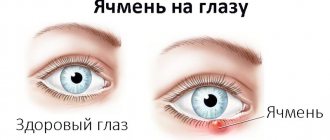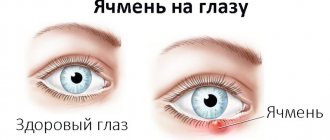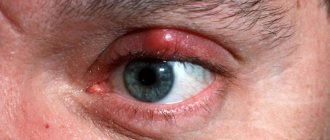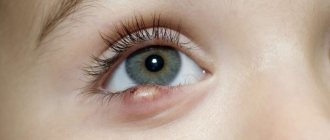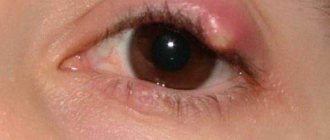What is barley?
The delicate skin of the eyelids along the eyelash line is rich in sebaceous glands, which are also called Zeiss glands. If an infection enters the cavity of one of these glands, an external stye is formed.
It is an acute inflammation, accompanied by the formation of a purulent sac on the edge of the eyelid.
There is also an internal stye, in which the abscess is located on the inside of the eyelid and from the outside appears to be just a swelling.
Its formation is caused by an inflammatory process in the meibomian glands, which secrete lubricant for the cornea and conjunctiva. The openings of these glands can be seen by slightly turning the edge of the lower eyelid.
When the outer stye breaks out, the pus ends up on the skin, while the inner one opens up inside the eye, seeding the conjunctiva and orbit with microbes, and therefore much more often causes complications.
Despite the external differences, both forms of the disease are caused by the same pathogen. This is Staphylococcus aureus. About 40% of the population is a carrier of Staphylococcus aureus, most of them women.
Not everyone has a microbe that makes itself felt by any unpleasant manifestations, but if personal hygiene is not observed, immunity is reduced, or some concomitant diseases, the likelihood of finding a painful swelling on your eyelid increases significantly.
Also at risk are children who have not yet learned all the rules of hygiene, and elderly people weakened by age.
Nature of the disease
The main cause of the disease is Staphylococcus aureus. This is a gram-positive bacterium that can infect any person, regardless of age.
Staphylococcus aureus is the causative agent of a large number of dangerous pathologies. Enters the body by airborne droplets or contact. It does not appear for a long time, but with influenza, pneumonia or other pathologies that weaken the immune system, it begins to actively multiply, causing painful symptoms.
Staphylococcus aureus settles in the sebaceous glands, eyelash bulbs on the eyelids and becomes clogged. Thus, the formation of the hordeolum begins. The sore eye swells, the temperature rises as a result of the proliferation of a pathogenic microorganism, and a severe headache appears.
Some call hordeolum "the disease of dirty hands." The development of the disease begins due to infection in the eye area with dirty fingers. A healthy person has been in contact with an infected person or does not follow hygiene rules.
In 80% of cases, the pathology appears due to other inflammatory eye diseases, prolonged stressful situations, due to severe exhaustion of the body or improper facial care. The cause may be contact lenses that are worn for too long without being washed in a special solution.
Is it possible to get infected with stye?
Staphylococcus aureus, which causes the formation of barley, is contagious, but is not transmitted by airborne droplets. In order to get it from someone, direct contact with purulent discharge is necessary.
But since it would hardly occur to anyone to come into contact with their eyelids and eyeballs with a person suffering from stye.
And at the moment of breakthrough, very little pus is released, and the patient usually quickly disinfects his hands, face and the wound left after opening the inflamed gland; the likelihood of this is very low.
Nevertheless, it exists. By using common hygiene items with the patient - towels, handkerchiefs, as well as cosmetics, you can introduce microparticles of pus directly onto the mucous membrane of your eyelids.
Sleeping together is fraught with the same thing, because most often the abscess opens at night, during sleep. This can also result from accidental contact with hands that are dirty after opening the barley.
This route of infection is most likely in young children who are not able to independently disinfect fingers contaminated with microbes and at the same time actively contact with peers.
In general, you should not be afraid of the possibility of infection, but you should not neglect it either. In order not to give barley to others and not to catch it yourself, it is enough to follow a few simple rules:
| № | Action |
| 1. | Do not share hygiene items with the patient, even in the early stages of the disease, and under no circumstances use the same shadows, mascara, or eyeliner with him. If a stye appears on your eyelid, do not forget to use separate towels and handkerchiefs, washing and ironing them regularly. They should be kept away from hygiene items of healthy family members. |
| 2. | If you have stye, you should wash your hands with soap and water as often as possible. |
| 3. | Do not sleep in the same bed with a sick person, and especially not on the same pillow. |
| 4. | When the stye has broken through, you need to wipe the skin stained with pus with alcohol, and then wash your hands and face with any antimicrobial agent |
Clothes, linen, and towels that have contained the contents of barley must be washed and ironed with a hot iron.
How to protect yourself and your loved ones
It is possible to infect other people with hordeolum, but this is the exception rather than the rule. But since the abscess is bacterial in nature, some safety measures should be taken:
- the patient does not have to be isolated, but he must have personal hygiene products;
- You cannot use decorative cosmetics if you have suffered from stye;
- After contact with a patient or medical manipulation, it is important to thoroughly wash your hands;
- You cannot sleep in a shared bed with a patient and use the same pillow;
- if the abscess has opened and the contents have spilled onto linen or clothes, they must be boiled;
- strengthen the immune system and maintain eye hygiene.
Staphylococcus aureus, which is the main “culprit” for the occurrence of barley, always lives in our body and is carried by 50% of people. But if the immune system is strong, it does not manifest itself in any way. Therefore, strengthen your defenses and look at the world with wide open eyes.
Prevention and treatment
In order to prevent the appearance of barley, first of all it is necessary to maintain immunity at a sufficient level, then Staphylococcus aureus, even if it is permanently present in the body, will not be able to manifest itself in any way.
For the same reason, it is better to avoid colds, hypothermia, and serious stress - all these events weaken the natural resistance to pathogenic microbes.
The importance of following hygiene rules does not need to be mentioned again. By protecting yourself from contact with infected pus, you will most likely save yourself from joining the host of carriers of Staphylococcus aureus.
Routes of infection
It is necessary to consider in detail the likely routes of infection. After all, such a possibility still exists. There are two main options. This is a contact method and a contact-household method. They are the ones that cause a lot of controversy.
Contact method
It involves direct contact with pus from a sick person. Moreover, it must flow out of the barley sac, since only there an infection is contained that can cause transmission of the disease to another person. Again, the pus should end up on the eyelid or an anatomical area close to the eye. If it just ends up on the skin of your hands or body, it will not lead to infection;
Contact-household method
It consists of transmitting the disease through dishes, communication, touch, clothing, and so on. It should be understood that it is possible to become infected in this way only if the disease affects the entire body. For example, with ARVI, a person’s breath contains pathogenic bacteria. They lead to the transmission of the disease.
This does not happen with barley. This is not an internal state of the body. After all, infectious pus is localized and contained in the barley sac. Therefore, another person cannot become infected through ordinary household contact.
| Thus, for infection, contact is necessary not with the carrier of the disease itself, but with pus from the barley sac. And it should hit the same anatomical area. In other cases, the disease is not dangerous to other people. |
What to do if the eyelid has already begun to swell treacherously, and the eye is red and watery?
When barley has just begun to grow, you can try to slow down its development with antibiotics. Most often, eye ointments are used for this: Tetracycline, Levomekol, Acyclovir.
It is recommended to apply them directly to the area of the inflamed sebaceous gland. Drops based on antibacterial agents are widely used in conjunction with ointments, primarily Levomycetin, Albucid, Tobrex.
If several styes appear on one eyelid, the doctor may prescribe antibiotic tablets. When an internal stye breaks through and the conjunctiva becomes infected, they often have the best effect.
There are also quite effective traditional methods of treatment. Fresh tansy flowers, taken orally, have a detrimental effect on the causative agent of the disease, and aloe leaf helps the abscess to ripen and open faster.
As an adjuvant, decoctions of herbs with anti-inflammatory effects, such as chamomile and plantain, are used. The inflamed eyelid is wiped with a cool decoction several times a day, this reduces itching and lacrimation.
It is important to remember that you cannot treat stye with lotions or compresses, they will only contribute to the spread of infection to the eye and its appendages.
If the development of events is favorable, the abscess breaks out in 2-4 days, and the remaining wound heals quickly.
How is the pathology treated?
After making a diagnosis, the ophthalmologist prescribes treatment. It consists of:
- instilling Albucid into the eyes, 2 drops every 2-3 hours,
- lubricating the barley with brilliant green or alcohol 3-4 times a day, but only if the barley is localized externally,
- applying a compress with chamomile infusion or tea bags to the eyes,
- applying a bandage lubricated with tetracycline or erythromycin ointment,
- physiotherapeutic methods: UHF, UV irradiation, heating and electrophoresis.
Staphylococcus aureus is completely resistant to antibiotics, so antibacterial therapy is not prescribed for barley.
If the opening of barley is accompanied by an increase in temperature, antipyretic drugs are prescribed.
After opening the abscess, it is recommended to use antiseptic solutions for washing the eyes (Furacilin, Sulfacyl sodium), antibacterial drops and ointments (Sofradex, Levomycetin, Tobrex, Gentamicin). It is allowed to treat the affected area with salicylic alcohol.
In severe cases, the stye can open inside the eye in such a way that the purulent contents spill inside. As a result, a rough growth, a chalazion, is formed, which sometimes needs to be removed surgically.
If the abscess is formed inside the eye or the formation is multiple, treatment is carried out in a hospital setting. If necessary, the abscess is opened surgically under local anesthesia, after which antibacterial drugs are prescribed: penicillin, gentamicin, erythromycin, cephalosporin. To strengthen the immune system, vitamins and sodium thiosulfate are prescribed.
The most popular folk remedies are lotions and compresses made from the following components:
- aloe juice diluted with water (1:10),
- plantain infusion,
- birch decoction,
- dill decoction.
A warm boiled egg helps a lot; it should be applied to the inflamed area, first wrapped in a napkin. In the summer, you can use a simple method: stand for 10-15 minutes in direct sunlight.
After recovery, it is better not to use decorative cosmetics for a week to avoid relapses of the disease.
Useful video
How to get rid of stye:
Results
To conclude this article, let's say the following:
- Almost half of the world's population is carriers of Staphylococcus aureus, the microbe that causes barley.
- Internal stye is much more dangerous than external stye, since when opened, the pus gets under the eyelid and does not come out.
- The disease is practically not contagious, but if hygiene rules are not followed, it can be transmitted from person to person.
- To avoid the appearance of barley, you should first of all take care of the general condition of the body.


